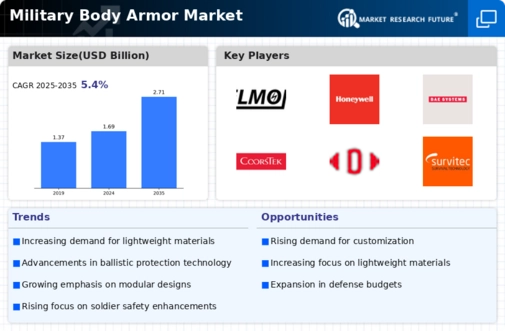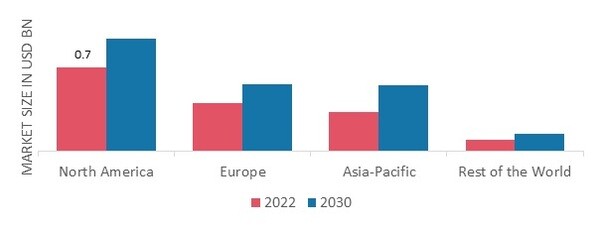-
EXECUTIVE SUMMARY
-
2.
-
SCOPE OF THE REPORT
-
MARKET DEFINITION
- DEFINITION
- LIST OF ASSUMPTIONS
-
2.2.
-
SCOPE OF THE STUDY
-
2.2.2.
-
RESEARCH OBJECTIVE
-
2.2.4.
-
LIMITATIONS
-
RESEARCH METHODOLOGY
-
3.1.
-
RESEARCH PROCESS
-
PRIMARY RESEARCH
-
3.3.
-
SECONDARY RESEARCH
-
MARKET SIZE ESTIMATION
-
3.5.
-
FORECAST MODEL
-
MARKET LANDSCAPE
-
4.1.
-
PORTER’S FIVE FORCES ANALYSIS
-
NEW ENTRANTS
-
4.1.3.
-
THREAT OF SUBSTITUTES
-
4.1.5.
-
BARGAINING POWER OF SUPPLIES
-
THREAT OF
-
BARGAINING POWER OF BUYERS
-
SEGMENT RIVALRY
-
VALUE CHAIN/SUPPLY
-
CHAIN ANALYSIS
-
MARKET DYNAMICS
-
INTRODUCTION
-
MARKET DRIVERS
-
MARKET RESTRAINTS
-
MARKET OPPORTUNITIES
-
MARKET
-
TRENDS
-
PATENT TRENDS
-
REGULATORY
-
LANDSCAPE
-
GLOBAL MILITARY BODY ARMOR MARKET, BY PROTECTION
-
LEVEL
-
INTRODUCTION
-
TYPE
- MARKET ESTIMATES & FORECAST, 2023-2030
- MARKET ESTIMATES & FORECAST, 2023-2030
- MARKET ESTIMATES & FORECAST BY REGION, 2023-2030
-
1
-
6.2.2.
-
MARKET ESTIMATES & FORECAST BY REGION, 2023-2030
-
6.3.
-
TYPE 2-A
-
TYPE 2
- MARKET ESTIMATES &
- MARKET ESTIMATES & FORECAST
-
FORECAST, 2023-2030
-
BY REGION, 2023-2030
-
TYPE 3-A
- MARKET
-
6.5.1.
-
MARKET ESTIMATES & FORECAST, 2023-2030
-
ESTIMATES & FORECAST BY REGION, 2023-2030
-
TYPE 3
- MARKET ESTIMATES & FORECAST, 2023-2030
- MARKET ESTIMATES & FORECAST, 2023-2030
- MARKET ESTIMATES & FORECAST BY REGION, 2023-2030
-
6.6.2.
-
MARKET ESTIMATES & FORECAST BY REGION, 2023-2030
-
6.7.
-
TYPE 4
-
GLOBAL MILITARY BODY ARMOR MARKET, BY PROTECTION TYPE
-
INTRODUCTION
-
BALLISTIC PROTECTION
- MARKET ESTIMATES & FORECAST, 2023-2030
- MARKET ESTIMATES & FORECAST,
- MARKET ESTIMATES & FORECAST BY REGION,
-
7.2.2.
-
MARKET ESTIMATES & FORECAST BY REGION, 2023-2030
-
7.3.
-
SPIKE PROTECTION
-
EDGED BLADE PROTECTION
- MARKET
-
7.4.1.
-
MARKET ESTIMATES & FORECAST, 2023-2030
-
ESTIMATES & FORECAST BY REGION, 2023-2030
-
GLOBAL MILITARY
-
BODY ARMOR MARKET, BY MATERIAL
-
INTRODUCTION
- MARKET ESTIMATES & FORECAST, 2023-2030
- MARKET ESTIMATES & FORECAST BY REGION, 2023-2030
-
8.2.
-
STEEL
-
COMPOSITE CERAMICS
- MARKET
- MARKET ESTIMATES
-
ESTIMATES & FORECAST, 2023-2030
-
& FORECAST BY REGION, 2023-2030
-
ARAMID
- MARKET
-
8.4.1.
-
MARKET ESTIMATES & FORECAST, 2023-2030
-
ESTIMATES & FORECAST BY REGION, 2023-2030
-
ULTRA-HIGH-MOLECULAR-WEIGHT
- MARKET ESTIMATES & FORECAST,
- MARKET ESTIMATES & FORECAST BY REGION,
-
POLYETHYLENE (UHMWPE)
-
OTHERS
- MARKET
- MARKET ESTIMATES
-
ESTIMATES & FORECAST, 2023-2030
-
& FORECAST BY REGION, 2023-2030
-
GLOBAL MILITARY BODY
-
ARMOR MARKET, BY REGION
-
INTRODUCTION
- MARKET ESTIMATES & FORECAST
- MARKET ESTIMATES & FORECAST
- MARKET ESTIMATES &
- MARKET ESTIMATES
- US
-
9.2.
-
NORTH AMERICA
-
BY COUNTRY, 2023-2030
-
BY PROTECTION LEVEL, 2023-2030
-
FORECAST BY PROTECTION TYPE, 2023-2030
-
& FORECAST BY MATERIAL, 2023-2030
-
9.2.5.1.
-
MARKET ESTIMATES & FORECAST BY PROTECTION LEVEL, 2023-2030
-
9.2.5.2.
-
MARKET ESTIMATES & FORECAST BY PROTECTION TYPE, 2023-2030
-
9.2.5.3.
-
MARKET ESTIMATES & FORECAST BY MATERIAL, 2023-2030
-
9.2.6.
-
CANADA
-
PROTECTION LEVEL, 2023-2030
-
FORECAST BY PROTECTION TYPE, 2023-2030
-
& FORECAST BY MATERIAL, 2023-2030
-
EUROPE
- GERMANY
- ITALY
-
9.3.1.
-
MARKET ESTIMATES & FORECAST BY COUNTRY, 2023-2030
-
9.3.2.
-
MARKET ESTIMATES & FORECAST BY PROTECTION LEVEL, 2023-2030
-
9.3.3.
-
MARKET ESTIMATES & FORECAST BY PROTECTION TYPE, 2023-2030
-
9.3.4.
-
MARKET ESTIMATES & FORECAST BY MATERIAL, 2023-2030
-
9.3.5.
-
UK
-
LEVEL, 2023-2030
-
BY PROTECTION TYPE, 2023-2030
-
FORECAST BY MATERIAL, 2023-2030
-
9.3.6.1.
-
MARKET ESTIMATES & FORECAST BY PROTECTION LEVEL, 2023-2030
-
9.3.6.2.
-
MARKET ESTIMATES & FORECAST BY PROTECTION TYPE, 2023-2030
-
9.3.6.3.
-
MARKET ESTIMATES & FORECAST BY MATERIAL, 2023-2030
-
9.3.7.
-
FRANCE
-
PROTECTION LEVEL, 2023-2030
-
FORECAST BY PROTECTION TYPE, 2023-2030
-
& FORECAST BY MATERIAL, 2023-2030
-
9.3.8.1.
-
MARKET ESTIMATES & FORECAST BY PROTECTION LEVEL, 2023-2030
-
9.3.8.2.
-
MARKET ESTIMATES & FORECAST BY PROTECTION TYPE, 2023-2030
-
9.3.8.3.
-
MARKET ESTIMATES & FORECAST BY MATERIAL, 2023-2030
-
9.3.9.
-
REST OF EUROPE
-
BY PROTECTION LEVEL, 2023-2030
-
& FORECAST BY PROTECTION TYPE, 2023-2030
-
ESTIMATES & FORECAST BY MATERIAL, 2023-2030
-
ASIA-PACIFIC
- MARKET ESTIMATES & FORECAST BY COUNTRY, 2023-2030
- MARKET ESTIMATES & FORECAST BY PROTECTION LEVEL,
- MARKET ESTIMATES & FORECAST BY PROTECTION
- MARKET ESTIMATES & FORECAST BY
- CHINA
- INDIA
-
TYPE, 2023-2030
-
MATERIAL, 2023-2030
-
9.4.5.1.
-
MARKET ESTIMATES & FORECAST BY PROTECTION LEVEL, 2023-2030
-
9.4.5.2.
-
MARKET ESTIMATES & FORECAST BY PROTECTION TYPE, 2023-2030
-
9.4.5.3.
-
MARKET ESTIMATES & FORECAST BY MATERIAL, 2023-2030
-
9.4.6.
-
JAPAN
-
LEVEL, 2023-2030
-
BY PROTECTION TYPE, 2023-2030
-
FORECAST BY MATERIAL, 2023-2030
-
9.4.7.1.
-
MARKET ESTIMATES & FORECAST BY PROTECTION LEVEL, 2023-2030
-
9.4.7.2.
-
MARKET ESTIMATES & FORECAST BY PROTECTION TYPE, 2023-2030
-
9.4.7.3.
-
MARKET ESTIMATES & FORECAST BY MATERIAL, 2023-2030
-
9.4.8.
-
REST OF ASIA-PACIFIC
-
FORECAST BY PROTECTION LEVEL, 2023-2030
-
& FORECAST BY PROTECTION TYPE, 2023-2030
-
ESTIMATES & FORECAST BY MATERIAL, 2023-2030
-
MIDDLE
- MARKET ESTIMATES & FORECAST
- MARKET ESTIMATES & FORECAST
- MARKET ESTIMATES &
- MARKET ESTIMATES
-
EAST & AFRICA
-
BY COUNTRY, 2023-2030
-
BY PROTECTION LEVEL, 2023-2030
-
FORECAST BY PROTECTION TYPE, 2023-2030
-
& FORECAST BY MATERIAL, 2023-2030
-
LATIN AMERICA
- MARKET ESTIMATES & FORECAST BY COUNTRY, 2023-2030
- MARKET ESTIMATES & FORECAST BY PROTECTION LEVEL,
- MARKET ESTIMATES & FORECAST BY PROTECTION
- MARKET ESTIMATES & FORECAST BY
-
TYPE, 2023-2030
-
MATERIAL, 2023-2030
-
COMPETITIVE LANDSCAPE
-
10.1.
-
COMPETITIVE SCENARIO
-
COMPETITIVE OVERVIEW
-
COMPETITIVE BENCHMARKING
-
MARKET
-
SHARE ANALYSIS
-
10.1.5.
-
MERGER & ACQUISITION
-
NEW PRODUCT DEVELOPMENT
-
COMPANY PROFILE
-
11.1.
-
3M (US)
-
11.1.2.
-
PRODUCT OFFERING
-
11.1.4.
-
KEY DEVELOPMENTS
-
11.1.6.
-
STRATEGY
-
11.2.1.
-
COMPANY OVERVIEW
-
11.2.3.
-
FINANCIAL OVERVIEW
-
11.2.5.
-
COMPANY OVERVIEW
-
FINANCIAL OVERVIEW
-
SWOT ANALYSIS
-
BAE SYSTEMS (UK)
- PRODUCT OFFERING
- KEY DEVELOPMENTS
-
SWOT ANALYSIS
-
11.3.
-
COORSTEK INC. (US)
-
11.3.2.
-
PRODUCT OFFERING
-
11.3.4.
-
KEY DEVELOPMENTS
-
11.3.6.
-
STRATEGY
-
11.4.1.
-
COMPANY OVERVIEW
-
11.4.3.
-
FINANCIAL OVERVIEW
-
11.4.5.
-
STRATEGY
-
COMPANY OVERVIEW
-
FINANCIAL OVERVIEW
-
SWOT ANALYSIS
-
DU PONT (US)
- PRODUCT OFFERING
- KEY DEVELOPMENTS
-
SWOT ANALYSIS
-
11.5.
-
ELMON (GREECE)
-
11.5.2.
-
PRODUCT OFFERING
-
11.5.4.
-
KEY DEVELOPMENTS
-
11.5.6.
-
STRATEGY
-
OFFERING
-
11.6.4.
-
KEY DEVELOPMENTS
-
11.6.6.
-
STRATEGY
-
11.7.1.
-
COMPANY OVERVIEW
-
11.7.3.
-
FINANCIAL OVERVIEW
-
11.7.5.
-
STRATEGY
-
COMPANY OVERVIEW
-
FINANCIAL OVERVIEW
-
SWOT ANALYSIS
-
HONEYWELL INTERNATIONAL INC. (US)
- COMPANY OVERVIEW
- PRODUCT
- FINANCIAL OVERVIEW
- SWOT ANALYSIS
-
MKU LIMITED (INDIA)
- PRODUCT OFFERING
- KEY DEVELOPMENTS
-
SWOT ANALYSIS
-
11.8.
-
POINT BLANK ENTERPRISES, INC. (US)
-
OVERVIEW
-
11.8.3.
-
FINANCIAL OVERVIEW
-
11.8.5.
-
STRATEGY
-
COMPANY
-
PRODUCT OFFERING
-
KEY DEVELOPMENTS
-
SWOT ANALYSIS
-
11.9.
-
SAFARILAND, LLC (US)
-
11.9.2.
-
PRODUCT OFFERING
-
11.9.4.
-
KEY DEVELOPMENTS
-
11.9.6.
-
STRATEGY
-
11.10.1.
-
COMPANY OVERVIEW
-
11.10.3.
-
FINANCIAL OVERVIEW
-
11.10.5.
-
STRATEGY
-
COMPANY OVERVIEW
-
FINANCIAL OVERVIEW
-
SWOT ANALYSIS
-
SURVITEC GROUP LIMITED (UK)
- PRODUCT OFFERING
- KEY DEVELOPMENTS
-
SWOT ANALYSIS
-
-
STRATEGY
-
LIST OF TABLES
-
GLOBAL MILITARY BODY ARMOR
-
MARKET: BY REGION, 2023-2030
-
NORTH AMERICA:
-
MILITARY BODY ARMOR MARKET: BY COUNTRY, 2023-2030
-
Table 3
-
EUROPE MILITARY BODY ARMOR MARKET: BY COUNTRY, 2023-2030
-
Table
-
ASIA-PACIFIC MILITARY BODY ARMOR MARKET: BY COUNTRY, 2023-2030
-
ROW MILITARY BODY ARMOR MARKET: BY COUNTRY,
-
GLOBAL MILITARY BODY ARMOR MARKET,
-
BY PROTECTION TYPE, BY REGIONS, 2023-2030
-
NORTH
-
AMERICA: MILITARY BODY ARMOR MARKET, BY PROTECTION TYPE, BY COUNTRY, 2023-2030
-
EUROPE MILITARY BODY ARMOR MARKET, BY PROTECTION TYPE,
-
BY COUNTRY, 2023-2030
-
ASIA-PACIFIC MILITARY
-
BODY ARMOR MARKET BY PROTECTION TYPE, BY COUNTRY, 2023-2030
-
Table 10
-
ROW MILITARY BODY ARMOR MARKET BY PROTECTION TYPE, BY COUNTRY, 2023-2030
-
GLOBAL MILITARY BODY ARMOR MARKET BY MATERIAL: BY REGIONS,
-
NORTH AMERICA: MILITARY BODY ARMOR
-
MARKET BY MATERIAL: BY COUNTRY, 2023-2030
-
EUROPE
-
MILITARY BODY ARMOR MARKET BY MATERIAL: BY COUNTRY, 2023-2030
-
Table
-
ASIA-PACIFIC MILITARY BODY ARMOR MARKET BY MATERIAL: BY COUNTRY,
-
ROW MILITARY BODY ARMOR MARKET
-
BY MATERIAL: BY COUNTRY, 2023-2030
-
GLOBAL
-
MILITARY BODY ARMOR MARKET BY PROTECTION LEVEL: BY REGIONS, 2023-2030
-
NORTH AMERICA: MILITARY BODY ARMOR MARKET BY PROTECTION
-
LEVEL: BY COUNTRY, 2023-2030
-
EUROPE MILITARY
-
BODY ARMOR MARKET BY PROTECTION LEVEL: BY COUNTRY, 2023-2030
-
Table 19
-
ASIA-PACIFIC MILITARY BODY ARMOR MARKET BY PROTECTION LEVEL: BY COUNTRY, 2023-2030
-
ROW MILITARY BODY ARMOR MARKET BY PROTECTION
-
LEVEL: BY COUNTRY, 2023-2030
-
GLOBAL MILITARY
-
BODY ARMOR MARKET: BY REGION, 2023-2030
-
GLOBAL
-
MILITARY BODY ARMOR MARKET: BY PROTECTION TYPE, 2023-2030
-
Table 23
-
GLOBAL MILITARY BODY ARMOR MARKET: BY MATERIAL, 2023-2030
-
Table
-
GLOBAL MILITARY BODY ARMOR MARKET: BY PROTECTION LEVEL, 2023-2030
-
NORTH AMERICA: MILITARY BODY ARMOR MARKET,
-
BY COUNTRY
-
NORTH AMERICA: MILITARY BODY ARMOR
-
MARKET, BY PROTECTION TYPE
-
NORTH AMERICA:
-
MILITARY BODY ARMOR MARKET, BY MATERIAL
-
NORTH
-
AMERICA: MILITARY BODY ARMOR MARKET, BY PROTECTION LEVEL
-
Table 29
-
EUROPE: MILITARY BODY ARMOR MARKET, BY COUNTRY
-
Table 30
-
EUROPE: MILITARY BODY ARMOR MARKET, BY PROTECTION TYPE
-
Table
-
EUROPE: MILITARY BODY ARMOR MARKET, BY MATERIAL
-
EUROPE: MILITARY BODY ARMOR MARKET, BY PROTECTION
-
LEVEL
-
ASIA-PACIFIC: MILITARY BODY ARMOR
-
MARKET, BY COUNTRY
-
ASIA-PACIFIC: MILITARY
-
BODY ARMOR MARKET, BY PROTECTION TYPE
-
ASIA-PACIFIC:
-
MILITARY BODY ARMOR MARKET, BY MATERIAL
-
ASIA-PACIFIC:
-
MILITARY BODY ARMOR MARKET, BY PROTECTION LEVEL
-
Table 37
-
ROW: MILITARY BODY ARMOR MARKET, BY REGION
-
Table 38
-
ROW MILITARY BODY ARMOR MARKET, BY PROTECTION TYPE
-
Table 39
-
ROW MILITARY BODY ARMOR MARKET, BY MATERIAL
-
Table 40
-
ROW MILITARY BODY ARMOR MARKET, BY PROTECTION LEVEL
-
LIST
-
OF FIGURES
-
RESEARCH PROCESS OF MRFR
-
FIGURE
-
TOP-DOWN & BOTTOM-UP APPROACH
-
FIGURE 3
-
MARKET DYNAMICS
-
IMPACT ANALYSIS: MARKET DRIVERS
-
IMPACT ANALYSIS: MARKET RESTRAINTS
-
FIGURE 6
-
PORTER'S FIVE FORCES ANALYSIS
-
VALUE CHAIN
-
ANALYSIS
-
GLOBAL MILITARY BODY ARMOR MARKET SHARE,
-
BY PROTECTION LEVEL, 2023 (%)
-
GLOBAL MILITARY BODY
-
ARMOR MARKET, BY PROTECTION LEVEL, 2023-2030 (USD MILLION)
-
FIGURE 10
-
GLOBAL MILITARY BODY ARMOR MARKET SHARE, BY PROTECTION TYPE, 2023 (%)
-
FIGURE
-
GLOBAL MILITARY BODY ARMOR MARKET, BY PROTECTION TYPE, 2023-2030
-
(USD MILLION)
-
GLOBAL MILITARY BODY ARMOR MARKET
-
SHARE, BY MATERIAL, 2023 (%)
-
GLOBAL MILITARY BODY
-
ARMOR MARKET, BY MATERIAL, 2023-2030 (USD MILLION)
-
GLOBAL
-
MILITARY BODY ARMOR MARKET SHARE (%), BY REGION, 2023
-
FIGURE 15
-
GLOBAL MILITARY BODY ARMOR MARKET, BY REGION, 2023-2030 (USD MILLION)
-
FIGURE
-
NORTH AMERICA: MILITARY BODY ARMOR MARKET SHARE (%), 2023
-
NORTH AMERICA: MILITARY BODY ARMOR MARKET BY COUNTRY,
-
EUROPE MILITARY BODY ARMOR
-
MARKET SHARE (%), 2023
-
EUROPE MILITARY BODY ARMOR
-
MARKET BY COUNTRY, 2023-2030 (USD MILLION)
-
ASIA-PACIFIC
-
MILITARY BODY ARMOR MARKET SHARE (%), 2023
-
ASIA-PACIFIC
-
MILITARY BODY ARMOR MARKET BY COUNTRY, 2023-2030 (USD MILLION)
-
FIGURE 22
-
REST OF THE WORLD MILITARY BODY ARMOR MARKET SHARE (%), 2023
-
FIGURE 23
-
REST OF THE WORLD MILITARY BODY ARMOR MARKET BY COUNTRY, 2023-2030 (USD MILLION)











Leave a Comment